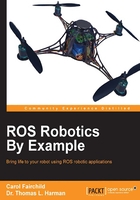
Chapter 2. Creating Your First Two-Wheeled ROS Robot (in Simulation)
Your first robot will be created in simulation so that even if you do not have a robot to learn ROS on, you will be able to follow along and do the exercises in this book. We will build a simple two-wheeled robot named dd_robot (dd is short for a differential drive). We will build a Unified Robot Description Format (URDF) file for the robot that will describe the main components of our robot and enable it to be visualized and controlled by ROS tools, such as rviz and Gazebo. Rviz is a visualization tool in which we will view our dd_robot URDF file as we build it in increments. When the visual model is complete, we will modify the URDF file for use in the Gazebo simulator. In Gazebo, we can view the effects of physics on our model as we move our model around the 3D environment.
In this chapter, we will cover the following topics:
- An introduction to rviz, installation instructions, and instructions for use
- How to create and build a ROS package
- An incremental approach to develop a URDF file and visualize it in rviz
- URDF tools to verify the URDF file
- An introduction to Gazebo, installation instructions, and instructions for use
- Modifications necessary to visualize the URDF file in Gazebo
- Tools to verify your Gazebo URDF/Simulation Description Format (SDF) file
- A simple way to control a robot in Gazebo
We begin by learning about rviz.